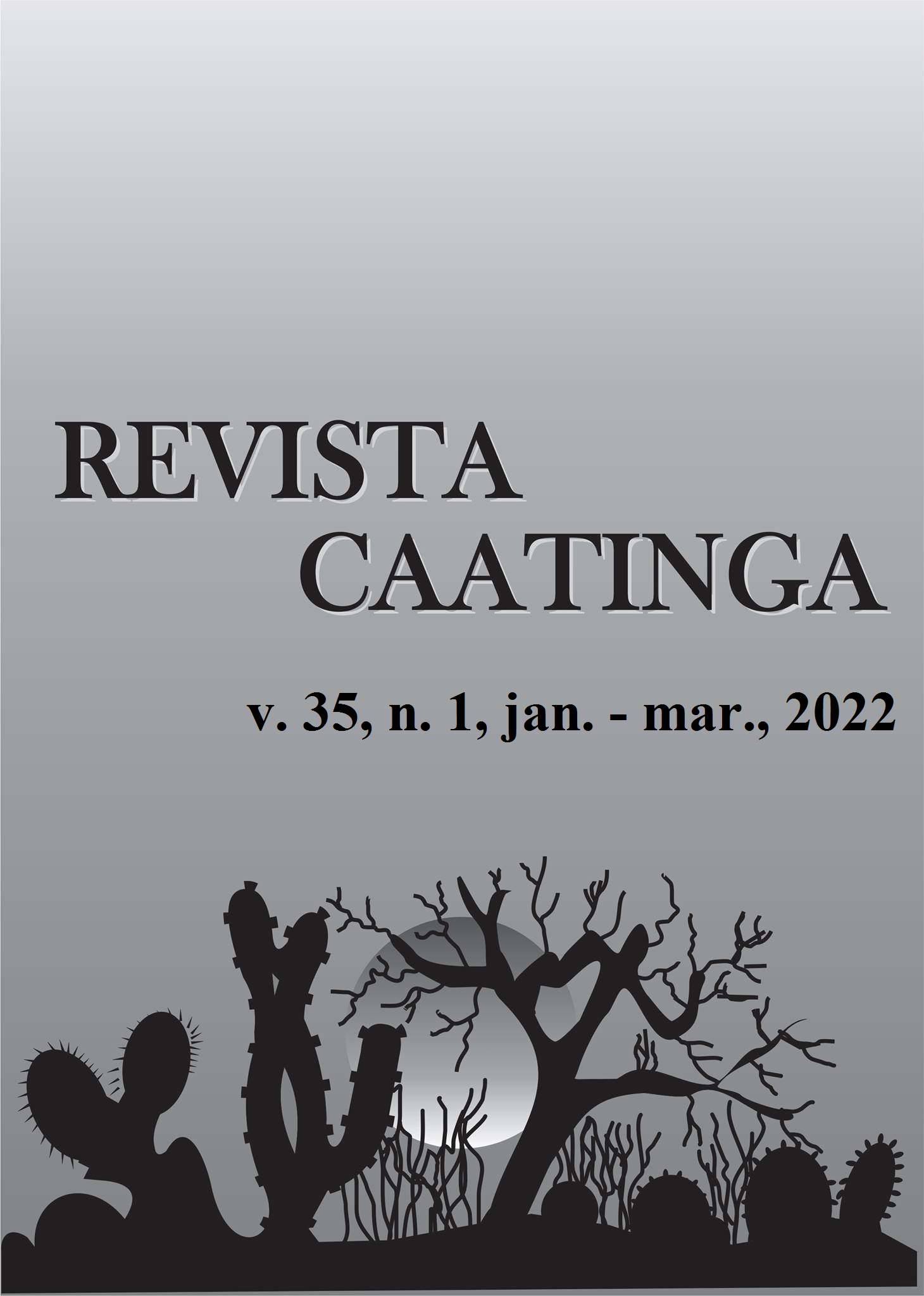PARASITISMO NATURAL EM Triozoida limbata (Enderlein, 1918) (HEMIPTERA: TRIOZIDAE) NO SEMIÁRIDO MINEIRO
DOI:
https://doi.org/10.1590/1983-21252022v35n125rcPalavras-chave:
Controle biológico. Psilídeo da goiabeira. Parasitoides. Psyllaephagus trioziphagus.Resumo
Para que os inimigos naturais sejam usados em programas de controle de pragas, é importante entender a ecologia básica e aplicada de um agroecossistema, como nos pomares de goiaba em uma região semiárida. O presente trabalho teve como objetivo conhecer os parasitoides associados ao psilídeo da goiabeira, Triozoida limbata (Enderlein 1918) (Hemiptera: Triozidae), bem como o índice de parasitismo na região semiárida do norte de Minas Gerais. Cerca de 130 ramos terminais com quatro folhas totalmente abertas e com sinais e/ou presença do psilídeo foram coletados em um pomar comercial de goiabeira e levados ao laboratório. O material foi mantido sob condições controladas até a emergência dos parasitoides, que foram contabilizados e fixados em álcool 70%, para posterior identificação. No total foram encontrados 9.897 indivíduos de T. limbata (adultos imaturos) e 603 parasitoides. Foram associados ao psilídeo da goiabeira, o parasitoide primário, Psyllaephagus trioziphagus (Howard, 1885) (Hymenoptera: Encyrtide), com 4,88% de parasitismo e os secundários, Signiphora Ashmead, 1880 (Hymenoptera: Signiphoridae), Aprostocetus Westwood, 1833 e Tetrastichus Haliday, 1844 (Hymenoptera: Eulophidae).
Downloads
Referências
BOTI, J. B. et al. Insetos provocadores de danos em folhas, flores e frutos da goiabeira (Psidium guajava L., Myrtaceae) nos pomares conduzidos em sistema de cultivo convencional e orgânico, no município de Santa Teresa-ES. Natureza On Line, 14: 40-44, 2016.
BURCKHARDT, D.; QUEIROZ, D. L. Checklist and comments on the jumping plant-lice (Hemiptera: Psylloidea) from Brazil. Zootaxa, 3571: 26-48, 2012.
COSTA, V. A.; QUEIROZ, D. L.; SILVA, N. A. Psyllaephagus trioziphagus (Hymenoptera: Encyrtidae), parasitoide de Mastigimas anjosi (Hemiptera: Calophyidae). Pesquisa Florestal Brasileira, 35: 339-342, 2015.
DRUMMOND, G. M. et al. Biodiversidade em Minas Gerais: um atlas para sua conservação. 2. ed. Belo Horizonte, MG: Fundação Biodiversitas, 2005. 222 p.
FERNÁNDEZ, F., SHARKEY, M. J. Introducción a los Hymenoptera de la región Neotropical. Bogotá: Sociedad Colombiana de Entomología y a Univerdidad Nacional de Colombia. 2006. 894 p.
GAGIC, V. et al. Agricultural intensification and cereal aphid–parasitoid– hyperparasitoid food webs: network complexity, temporal variability and parasitism rates. Oecologia, 170: 1099-1109, 2012.
HODKINSON, I. D. The biology of Strophingia ericae (Curtis) (Homoptera, Psylloidea) with notes on is primary parasite Tetrastichus actis (Walker) (Hym., Eulophidae). Norsk Ententomologisk Tidsskrift, 20: 337-243, 1973.
MARTINS, F. B. et al. Classificação climática de Köppen e de Thornthwaite para Minas Gerais: Cenário atual e projeções futuras. Revista Brasileira de Climatologia, 14: 129-156, 2018.
MELO, G. A. R.; AGUIAR, A. P.; GARCET-BARRETT, B. R. Hymenoptera Linnaes, 1758. In: RAFAEL, J. A. et al. (Eds.), Insetos do Brasil diversidade e taxonomia. Ribeirão Preto, SP: Holos, 2012. v. 1. cap. 35 p. 553-612.
NOYES, J. S. A review of the genera of Neotropical Encyrtidae (Hymenoptera: Chalcidoidea). Bulletin of the British Museum (Natural History), 41: 107-253, 1980.
NOYES, J. S. Universal Chalcidoidea Database. World Wide Web electronic publication. 2019. Disponível em: <http://www.nhm.ac.uk/chalcidoids>. Acesso em: 12 fev. 2020.
NOYES, J. S.; HANSON, P. Encyrtidae (Hymenoptera: Chalcidoidea) of Costa Rica: The genera and species associated with jumping plantlice (Homoptera: Psylloidea). Bulletin of the British Museum (Natural History), 65: 10-164, 1996.
ROSSI, L. M. et al. Agentes de controle biológico (Arthropoda - Insecta) associados ao cultivo da pinha (Annona squamosa L.). Revista Agro@mbiental On-line, 11: 82-87, 2017.
SÁ, V. A.; FERNANDES, M. G. Himenópteros parasitoides associados a ninfas de Triozoida limbata na cultura da goiabeira, em Ivinhema, MS, Brasil. Ciência Rural, 45: 19-21, 2015b.
SÁ, V. A.; FERNANDES, M. G. Spatial distribution of nymphs of Triozoida limbata Enderlein, 1918 (Hemiptera: Triozidae) in guava orchards. Journal of Agricultural Science, 7: 41-54, 2015a.
SCHAUFF, M. E.; LASALLE, J.; COOTE, L. D. Eulophidae. In: GIBSON, G. A. P.; HUBER, J. T.; WOOLLEY, J. B. (Eds.). Annotated keys to the genera of Nearctic Chalcidoidea (Hymenoptera). Ottawa, ON: NRC Research Press, 1997. v. 1, cap. 10. p. 327-429.
SEMEÃO, A. A. et al. Life tables for the guava psyllid Triozoida limbata in southeastern Brazil. BioControl, 57: 779-788, 2012b.
SEMEÃO, A. A. et al. Seasonal variation of natural mortality factors of the guava psyllid Triozoida limbata. Bulletin of Entomological Research, 102: 719-729, 2012a.
SINGH, S. Description of a new species of Psyllaephagus Ashmead (Hymenoptera: Encyrtidae) parasitizing pit gall forming psyllid Trioza fletcheri (Hemiptera: Psylloidea: Triozidae) on Terminalia arjuna from India. Annales Zoologici, 66: 393-402, 2016.
TAVARES, R. M. et al. Electrostatic spraying in the chemical control of Triozoida limbata (Enderlein) (Hemiptera: Triozidae) in guava trees (Psidium guajava L.). Pest Management Science, 73: 1148-1153, 2016.
WATERSTON, J. On the Chalcidoid parasites of psyllids (Hemiptera, Homoptera). Bulletin of Entomological Research, 13: 41-58, 1922.
WOOLLEY, J. B.; MOLIN, A. D. Taxonomic revision of the flavopalliata species group of Signiphora (Hymenoptera: Signiphoridae). Zootaxa. 4315: 001–150, 2017.
Downloads
Publicado
Edição
Seção
Licença
Os Autores que publicam na Revista Caatinga concordam com os seguintes termos:
a) Os Autores mantêm os direitos autorais e concedem à revista o direito de primeira publicação, com o trabalho simultaneamente licenciado sob a Licença Creative Commons do tipo atribuição CC-BY, para todo o conteúdo do periódico, exceto onde estiver identificado, que permite o compartilhamento do trabalho com reconhecimento da autoria e publicação inicial nesta revista, sem fins comerciais.
b) Os Autores têm autorização para distribuição não-exclusiva da versão do trabalho publicada nesta revista (ex.: publicar em repositório institucional ou como capítulo de livro), com reconhecimento de autoria e publicação inicial nesta revista.
c) Os Autores têm permissão e são estimulados a publicar e distribuir seu trabalho online (ex.: em repositórios institucionais ou na sua página pessoal) a qualquer ponto antes ou durante o processo editorial, já que isso pode gerar alterações produtivas, bem como aumentar o impacto e a citação do trabalho publicado (Veja O Efeito do Acesso Livre).







